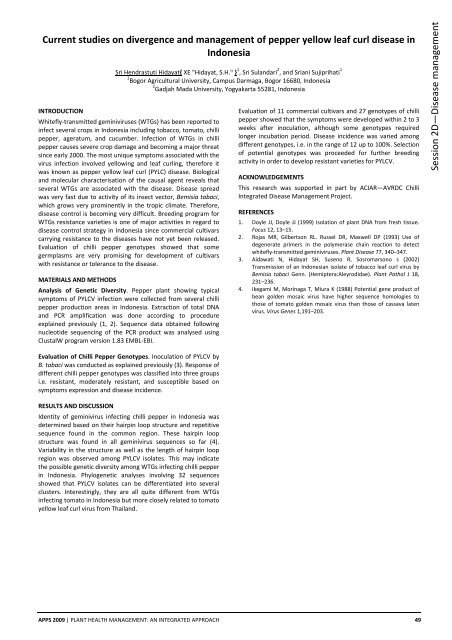View PDF - Australasian Plant Pathology Society
View PDF - Australasian Plant Pathology Society
View PDF - Australasian Plant Pathology Society
You also want an ePaper? Increase the reach of your titles
YUMPU automatically turns print PDFs into web optimized ePapers that Google loves.
Current studies on divergence and management of pepper yellow leaf curl disease in<br />
Indonesia<br />
INTRODUCTION<br />
Sri Hendrastuti Hidayat{ XE "Hidayat, S.H." } 1 , Sri Sulandari 2 , and Sriani Sujiprihati 1<br />
1 Bogor Agricultural University, Campus Darmaga, Bogor 16680, Indonesia<br />
2 Gadjah Mada University, Yogyakarta 55281, Indonesia<br />
Whitefly‐transmitted geminiviruses (WTGs) has been reported to<br />
infect several crops in Indonesia including tobacco, tomato, chilli<br />
pepper, ageratum, and cucumber. Infection of WTGs in chilli<br />
pepper causes severe crop damage and becoming a major threat<br />
since early 2000. The most unique symptoms associated with the<br />
virus infection involved yellowing and leaf curling, therefore it<br />
was known as pepper yellow leaf curl (PYLC) disease. Biological<br />
and molecular characterisation of the causal agent reveals that<br />
several WTGs are associated with the disease. Disease spread<br />
was very fast due to activity of its insect vector, Bemisia tabaci,<br />
which grows very prominently in the tropic climate. Therefore,<br />
disease control is becoming very difficult. Breeding program for<br />
WTGs resistance varieties is one of major activities in regard to<br />
disease control strategy in Indonesia since commercial cultivars<br />
carrying resistance to the diseases have not yet been released.<br />
Evaluation of chilli pepper genotypes showed that some<br />
germplasms are very promising for development of cultivars<br />
with resistance or tolerance to the disease.<br />
MATERIALS AND METHODS<br />
Analysis of Genetic Diversity. Pepper plant showing typical<br />
symptoms of PYLCV infection were collected from several chilli<br />
pepper production areas in Indonesia. Extraction of total DNA<br />
and PCR amplification was done according to procedure<br />
explained previously (1, 2). Sequence data obtained following<br />
nucleotide sequencing of the PCR product was analysed using<br />
ClustalW program version 1.83 EMBL‐EBI.<br />
Evaluation of 11 commercial cultivars and 27 genotypes of chilli<br />
pepper showed that the symptoms were developed within 2 to 3<br />
weeks after inoculation, although some genotypes required<br />
longer incubation period. Disease incidence was varied among<br />
different genotypes, i.e. in the range of 12 up to 100%. Selection<br />
of potential genotypes was proceeded for further breeding<br />
activity in order to develop resistant varieties for PYLCV.<br />
ACKNOWLEDGEMENTS<br />
This research was supported in part by ACIAR—AVRDC Chilli<br />
Integrated Disease Management Project.<br />
REFERENCES<br />
1. Doyle JJ, Doyle JJ (1999) Isolation of plant DNA from fresh tissue.<br />
Focus 12, 13–15.<br />
2. Rojas MR, Gilbertson RL. Russel DR, Maxwell DP (1993) Use of<br />
degenerate primers in the polymerase chain reaction to detect<br />
whitefly‐transmitted geminiviruses. <strong>Plant</strong> Disease 77, 340–347.<br />
3. Aidawati N, Hidayat SH, Suseno R, Sosromarsono s (2002)<br />
Transmission of an Indonesian isolate of tobacco leaf curl virus by<br />
Bemisia tabaci Genn. (Hemiptera:Aleyrodidae). <strong>Plant</strong> Pathol J 18,<br />
231–236.<br />
4. Ikegami M, Morinaga T, Miura K (1988) Potential gene product of<br />
bean golden mosaic virus have higher sequence homologies to<br />
those of tomato golden mosaic virus than those of cassava laten<br />
virus. Virus Genes 1,191–203.<br />
Session 2D—Disease management<br />
Evaluation of Chilli Pepper Genotypes. Inoculation of PYLCV by<br />
B. tabaci was conducted as explained previously (3). Response of<br />
different chilli pepper genotypes was classified into three groups<br />
i.e. resistant, moderately resistant, and susceptible based on<br />
symptoms expression and disease incidence.<br />
RESULTS AND DISCUSSION<br />
Identity of geminivirus infecting chilli pepper in Indonesia was<br />
determined based on their hairpin loop structure and repetitive<br />
sequence found in the common region. These hairpin loop<br />
structure was found in all geminivirus sequences so far (4).<br />
Variability in the structure as well as the length of hairpin loop<br />
region was observed among PYLCV isolates. This may indicate<br />
the possible genetic diversity among WTGs infecting chilli pepper<br />
in Indonesia. Phylogenetic analyses involving 32 sequences<br />
showed that PYLCV isolates can be differentiated into several<br />
clusters. Interestingly, they are all quite different from WTGs<br />
infecting tomato in Indonesia but more closely related to tomato<br />
yellow leaf curl virus from Thailand.<br />
APPS 2009 | PLANT HEALTH MANAGEMENT: AN INTEGRATED APPROACH 49







![[Compatibility Mode].pdf](https://img.yumpu.com/27318716/1/190x135/compatibility-modepdf.jpg?quality=85)









